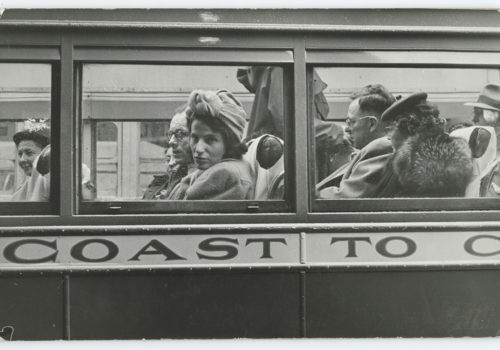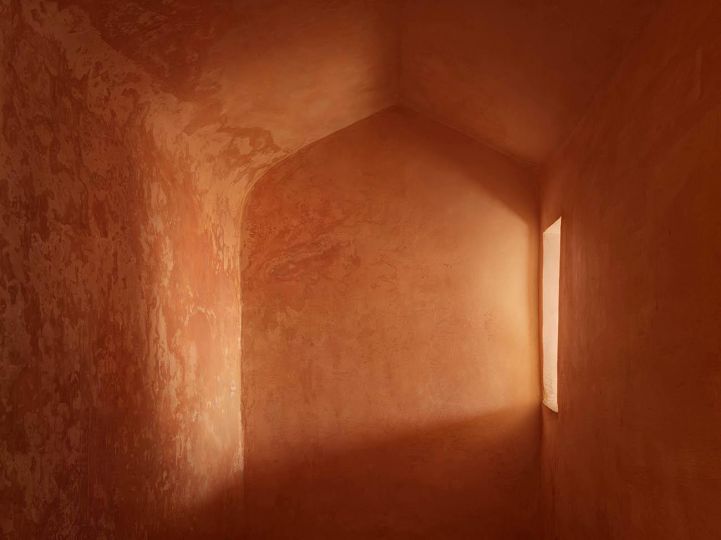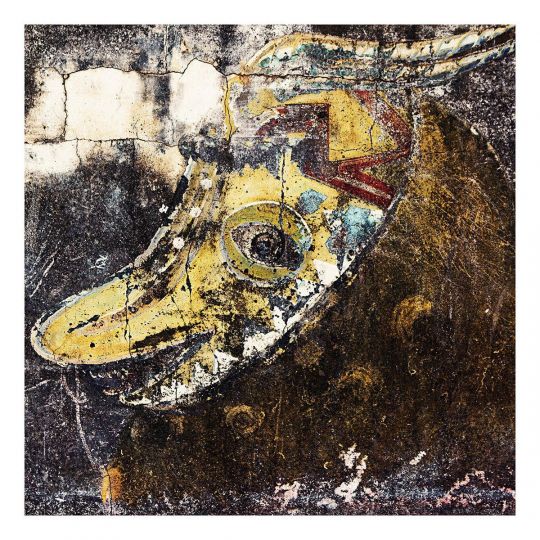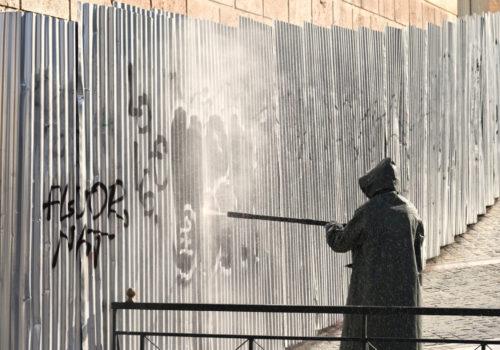Street photography—the thoroughly unpredictable and often magical framing of a moment—was embraced early in the 20th century by women photographers. A new exhibition at Howard Greenberg Gallery will survey more than seven decades of work by 12 women photographers. A Female Gaze is on view from January 19 through April 2, 2022 in the gallery’s new space on the 8th floor of the Fuller Building at 41 East 57th Street.
Firmly established in the canon of street photography, the artists in the exhibition—including Berenice Abbott, Diane Arbus, Jodi Bieber, Esther Bubley, Rebecca Lepkoff, Helen Levitt, Vivian Maier, Mary Ellen Mark, Frances McLaughlin-Gill, Lisette Model, Barbara Morgan, and Ruth Orkin—are known for remarkable and iconic images.
The forty-nine photographs in A Female Gaze span the 20th century: from the 1930s with Abbott’s documentation of New York City to images from Jodi Bieber’s ten-year project (1994 to 2004) focused on youth living on the fringes of South African society. These women not only transcribed history by taking ownership of their environments, but added their own voices to the narrative of photographic history.
The democratic nature of street photography reserved a creative space for female artists to a greater extent than other artistic fields. The Photo League, the New York cooperative active from 1936 to 1951, famously included a significant number of female members such as Berenice Abbott, Rebecca Lepkoff, Lisette Model, Ruth Orkin, and Barbara Morgan. These women not only held leadership positions but were encouraged equally alongside their male counterparts.
Regardless of the subject matter or the awards gained or the techniques implemented, this collective of female street photographers, as Mary Ellen Mark once remarked referring to the nature of her own work, “photograph the world as it is, because nothing is more interesting than reality.” These fleeting occurrences, which may have otherwise passed by unacknowledged, are perpetually suspended in time, generating the opportunity for viewers to consider the transitory phenomena of life.
About Berenice Abbott (1898-1991)
Born in Ohio, Berenice Abbott studied art in New York, Berlin, and Paris. Working as Man Ray’s studio assistant in Paris served as her introduction to the world of photography as well as to and French photographer Eugène Atget. Upon returning to New York in 1929, Abbott began to document the changing city, training her lens on the rapidly evolving urban fabric. In the 1930s, she was employed by the Federal Art Project, a subdivision of the Works Progress Administration, to continue her exploration of her series Changing New York. Abbott’s photographs from this series have been displayed in solo exhibitions at museums such as New York’s Whitney Museum of American Art and Museum of Modern Art. Her work is also part of collections such as the New York Public Library and the International Photography Hall of Fame, St. Louis.
About Diane Arbus (1923-1971)
Diane Arbus, known for her incisive, revealing photographs of people on the outskirts of society, began her career in the mid-1940s by producing commercial work for magazines. She left the world of corporate photography after taking a photography class at the New School for Social Research with the photographer Lisette Model. In 1963, the Guggenheim Foundation awarded Arbus a fellowship for her proposal and was awarded a renewal of her fellowship in 1966. The Smithsonian American Museum of Art, Washington; and the Metropolitan Museum of Art and the Museum of Modern Art, New York, are just of few of the collections which house Arbus’s photos.
About Jodi Bieber (born 1966)
Along with her contemporaries such as Zanele Muholi and Pieter Hugo, Jodi Bieber is known as one of South Africa’s most thoughtful and accomplished photographers. Bieber’s professional career began while covering the 1994 Democratic Elections in South Africa for The Star newspaper. In 2000, she covered an Ebola outbreak in Uganda for The New York Times Magazine. She has won numerous international awards including the Premier Award at World Press Photo in 2010. Her monographs include: Between Darkness and Light – Selected works: South Africa 1994-2010; Between Dogs and Wolves – Growing up with South Africa, 1996; Soweto, 2010; and Real Beauty, 2014. Her work is housed in collections such as The Walther Collection, New York; The Pinault Collection, Paris; the Johannesburg Art Gallery; and Iziko Museums of South Africa. In 2018, Bieber was nominated by the Royal Photographic Society as one of the Hundred Heroines, which celebrated women in photography across the globe and the centenary year of women’s suffrage in the UK.
About Esther Bubley (1921-1998)
Born in Phillips, Wisconsin, Esther Bubley moved to Washington, D.C., in 1940 to pursue work as a photographer. Later that year in New York Edward Steichen helped her land a temporary position at Vogue magazine. Bubley returned to Washington in 1941 and was hired as a microfilmer in the National Archives. She began taking photographs on the side and eventually was sent on assignments for the Farm Security Administration. While working for corporate clients, Bubley became a regular freelance photographer for numerous national magazines including Life. She published three books of her photographs – images of children, New York sites funded by the Rockefeller family, and a Charlie Parker jam session. Bubley’s photographs have been acquired by museums including the Metropolitan Museum of Art and the Museum of Modern Art; New York; the Library of Congress and the National Portrait Gallery, Washington; George Eastman House, Rochester, NY; and the Amon Carter Museum of American Art, Fort Worth.
About Rebecca Lepkoff (1916-2014)
Rebecca Lepkoff developed her eye under the tutelage of Arnold Eagle, the first of many idealistic Jewish photographers—including Sid Grossman, Paul Strand, and Walter Rosenblum—who introduced her to the Photo League and encouraged her to continue to document New York City. Her work has been featured in a number of books, galleries, and museum exhibitions, including A History of Women Photographers by Naomi Rosenblum; Bystander: A History of Street Photography by Joel Meyerowitz and Colin Westerbeck; and The Radical Camera, New York’s Photo League (1936-1951). In 2006, a monograph of her work, Life on the Lower East Side: Photographs by Rebecca Lepkoff, 1937-1950, was published. Lepkoff’s work is included in the collections of the National Museum of Art, Washington, D.C., the National Gallery of Canada, and the Museum of the City of New York.
About Helen Levitt (1913-2009)
A pioneer who worked outside of organized groups, Helen Levitt was inspired by the photographers Walker Evans and Henri Cartier-Bresson. She took to the streets after being unmoved by the prosaic nature of studio work. While teaching art classes to children in the 1930s for New York City’s Federal Art Project, Levitt became interested by children’s street culture, particularly their rudimentary chalk drawings. Acclaim for her work during her lifetime is realized in accomplishments such as her solo exhibition at the Museum of Modern Art, New York, being named a Photography Fellow of the National Endowment for the Arts, and receiving two grants from the Guggenheim Foundation.
About Vivian Maier (1926-2009)
Vivian Maier was an American street photographer whose massive, unseen body of work came to light when it was purchased from an auction in Chicago in 2007. Born in New York City, Maier spent some of her youth in France and then worked in Chicago as a nanny for most of her life. In her leisure, Maier ventured into the art of photography. Consistently taking photographs over the course of five decades, she would ultimately leave behind over 100,000 negatives. While her photographs have compelled viewers around the world since being brought to the public eye there is much that remains unknown about the enigmatic woman behind the lens. The contents of Maier’s storage space were purchased by several buyers at auction, including John Maloof, who has since dedicated himself to establishing her legacy. While he was unable to connect with Maier in her lifetime, Maloof shared a selection of Maier’s photographs online in 2009 and was met with viral interest. Compelled to learn more about the woman behind the lens, Maloof began to investigate the life and work of Maier, culminating in the Oscar-nominated documentary Finding Vivian Maier (2014). Since the discovery of her work, Maier’s photographs have been the subject of several publications and have been exhibited at major institutions throughout the world.
About Mary Ellen Mark (1940-2015)
In 1965, Mary Ellen Mark won a Fulbright Scholarship to photograph in Turkey for one year, an honor that Mark describes as “the beginning of my life’s photographic journey.” A Magnum member from 1971 to 1981, Mark taught photo workshops for over 30 years on her concepts and approaches to capturing intimate portraits. Mark saw the humanity of her subjects close-up and established strong bonds that allowed her into their worlds. Among her numerous accolades are three fellowships from the National Endowment for the Arts, the Lifetime Achievement in Photography Award from the George Eastman House, and the Outstanding Contribution Photography Award from the World Photography Organisation While Mark built a reputation as a photojournalist, contributing photo essays and portraits to publications such as Life, the New Yorker, Rolling Stone, Vanity Fair and the New York Times Magazine, her work has also been widely exhibited in galleries and museums around the globe. She published more than 20 books of her photographs and received numerous awards and grants for both photography and journalism.
Frances McLaughlin-Gill (1919-2014)
Frances McLaughlin-Gill was an American fashion photographer born in Brooklyn, NY, and raised in Wallingford, CT, with her twin sister Kathryn Abbe. Both sisters would go on to become photographers. In 1941 Frances received a BFA in Art and Design from the Pratt Institute. That same year her photograph of Jacqueline Bouvier was chosen as a finalist in Vogue’s Prix de Paris contest. In 1943, McLaughlin-Gill was hired by Alexander Liberman, Vogue’s new art director. She was the first woman photographer to sign a contract with Vogue. Throughout her 11 years at Vogue, McLaughlin-Gill nurtured her talent for capturing the casual, fleeting and intimate moments of her subjects. In addition, McLaughlin-Gill shot covers and editorial pages for Glamour, House & Garden, and British Vogue, among others. Her photographic style pioneered the realistic fashion photography of today.
About Lisette Model (1901-1983)
Lisette Model was not only known for her candid portraits on the streets of New York in the 1940s and 1950s, but her fascination with American consumerism. From this interest she photographed a series of reflections, which explored manufactured images, products, and consumers in windows. She was recognized for her radical deviation from traditional viewpoint, and her preoccupation with notions of glamour and anti-glamour. Model’s work resides in numerous permanent collections including the Whitney Museum of American Art, New York, and the George Eastman House, Rochester. Awarded a Guggenheim Fellowship in 1965, her photographs have been exhibited at institutions such as the National Gallery of Art and the Smithsonian Institution, Washington, D.C., and the Museum of Modern Art, New York.
About Barbara Morgan (1900-1992)
Barbara Morgan is best known for her iconic photographs of modern dancers including Martha Graham and Merce Cunningham. She was a co-founder of the photography magazine Aperture, along with Ansel Adams, Beaumont Newhall, Dorothea Lange, and others. Morgan worked in drawing and painting until 1935 when she became a mother and began to appreciate the instantaneous nature of photography. Her work was included by Edward Steichen in the Museum of Modern Art’s Family of Man exhibition. Her photographs were exhibited widely including a second solo show at the Museum of Modern Art, New York. She was friends with some the most creative minds of her time including Edward Weston, Gordon Parks, Margaret Mead, and Buckminster Fuller. In 1943, her photographs were exhibited at Black Mountain College to accompany a lecture by Josef Albers. Her archive can be found at the Center for Creative Photography at the University of Arizona.
About Ruth Orkin (1921-1985)
Ruth Orkin grew up in Hollywood in the heyday of the 1920s and 1930s. At 17, she took a monumental bicycle trip across the United States, from Los Angeles to New York City, to see the 1939 World’s Fair, and she photographed along the way. In 1943, she moved to New York and worked for major magazines. Orkin went to Italy in 1951 and met Nina Lee Craig, an art student and fellow American, who became the subject of her famous photograph American Girl in Italy. On her return to New York, Orkin married the photographer and filmmaker Morris Engel. Together they produced two feature films, including the classic Little Fugitive, which was nominated for an Academy Award in 1953. From their New York apartment overlooking Central Park, Orkin photographed marathons, parades, concerts, demonstrations, and the changing seasons. These photographs were the subject of two widely acclaimed books, A World Through My Window and More Pictures From My Window.
About Howard Greenberg Gallery
Since its inception in New York 40 years ago, Howard Greenberg Gallery has built a vast and ever-changing collection of some of the most important photographs in the medium. The Gallery’s collection acts as a living history of photography, offering genres and styles from Pictorialism to Modernism, in addition to contemporary photography and images conceived for industry, advertising, and fashion.
Formerly a photographer and founder of The Center for Photography in Woodstock in 1977, Howard Greenberg has been one of a small group of gallerists, curators and historians responsible for the creation and development of the modern market for photography. Howard Greenberg Gallery—founded in 1981 and originally known as Photofind—was the first to consistently exhibit photojournalism and street photography, now accepted as important components of photographic art.
The Gallery is located at two 57th Street locations: an exhibition space on the 8th floor of the Fuller Building at 41 East 57th Street; and an entire floor at 32 East 57th Street, directly across from the Fuller Building, to house, manage and present its vast archive of over 40,000 prints.
A Female Gaze : Seven Decades of Women Street Photographers
January 19 – April 2, 2022
Howard Greenberg Gallery
8th floor of the Fuller Building at 41 East 57th Street
New York, NY 10022
www.howardgreenberg.com
















